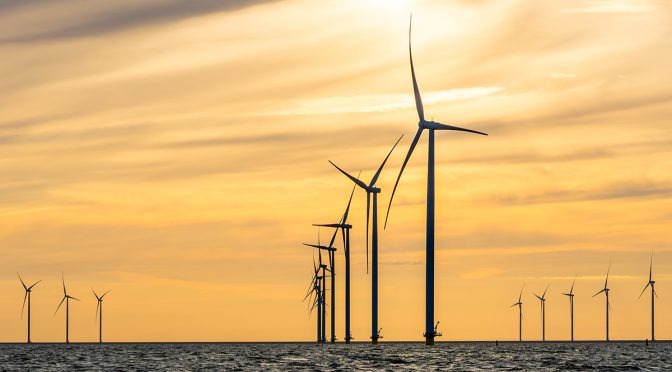
Significant investments are needed to unlock the potential 1,400 gigawatts of offshore wind in the Middle East and North Africa.
In its latest report, the World Wind Energy Council said Saudi Arabia, Morocco, Egypt and Oman could lead the way in developing this sector, which is still at a nascent stage as offshore activities in the region are mainly related to oil and gas.
This mode of power generation is considered crucial in the energy transition journey, as offshore wind energy is good for the environment because it generates electricity without burning fuel or emitting carbon dioxide.
Additionally, the wind at sea is stronger, more constant and less turbulent than on land, helping to generate power reliably.
“The significant potential of offshore wind energy indicates that there can (and should) be development in the Middle East. However, this largely depends on the investment environment, national regulations and permitting procedures, as well as the availability of a qualified workforce with experience in this industry,” the GWEC report says.
The document adds that the Middle East is yet to see any major development in offshore wind energy production due to the huge investments involved and onshore locations readily available.
“However, trends are changing in the Middle East. “Efforts to diversify energy sources, the potential development of subsea interconnectors with Europe and the potential for green energy and product exports may encourage MENA countries to reconsider their original stance on offshore wind,” GWEC said.
Saudi Arabia will become a key player
In its report, GWEC projected that Saudi Arabia has a total marine capacity of 106 GW along its eastern and western coasts.
The analysis further noted that Saudi Arabia’s increasing attention to renewable energy sources will catalyze the growth of wind power generation in the future.
“The oil-rich Kingdom currently has only one operational onshore wind farm (Dumat al Jandal), but has other ambitious renewable energy plans. By 2030, the country aims to generate half of its energy supply from renewable energy sources and reach net zero by 2060,” GWEC said.
According to the report, Saudi Arabia’s renewable energy goals, combined with the launch of massive green hydrogen projects and vision to export clean products, are expected to drive the development of onshore and offshore wind projects.
Morocco considers offshore wind projects
GWEC noted that the Moroccan government is seriously considering developing offshore wind energy projects, as the nation relies heavily on energy imports, with more than 91 percent of its energy coming from external sources.
Furthermore, the Moroccan government has made significant progress in the field of renewable energy and currently has a goal of reaching 51 percent of energy from green sources by the end of this decade.
“Although there are no set targets for the development of offshore wind, the government is taking serious steps to consider the possibility of this technology in the region,” GWEC said.
Additionally, the European Investment Bank recently awarded the Moroccan Agency for Sustainable Energy a $2 billion grant to conduct a feasibility study of offshore wind energy in Morocco.
A previous study conducted by GWEC had projected Morocco’s offshore wind potential at 200 GW.
Global outlook
According to the report, the industry connected 10.8 GW of offshore wind to the grid in 2023 representing a 24 percent year-on-year rise, bringing the total capacity to 75.2 GW globally.
China led the world in annual offshore wind developments for the sixth year in a row with 6.3 GW added last year.
On the other hand, Europe added 3.8 GW of new offshore wind capacity from 11 wind farms commissioned across seven markets accounting for most of the new capacity.
However, In North America, offshore wind turbines were installed at two utility-scale offshore wind projects in the US before the end of last year, but no offshore turbines were commissioned in 2023.
The report further noted that the offshore wind energy sector will witness a compound average annual growth rate of 25 percent until 2028 and 15 percent up to the early 2030s.
GWEC Market Intelligence added that at least 410 GW of new offshore wind capacity will be added between 2024 and 2033, of which more than two-thirds is likely to be added in the second half of this forecast period.
“The growth of offshore wind is now so much more than a European, Chinese, or American story. This global industry must now ‘chart a course’ for the tremendous growth that lies ahead,” said Rebecca Williams, chief strategy officer, offshore wind, at GWEC.
She added: “It’s important to note the offshore wind industry and its partners in government, institutions, and civil society are now coalescing and driving momentum in anticipation of the industry’s impending growth and importance as a clean energy technology.”
The report highlighted that the Membership of the Global Offshore Wind Alliance, a diplomatic, multi-stakeholder initiative founded by GWEC, the International Renewable Energy Agency, and Denmark has swelled to over 20 governments.
GWEC noted these 20 nations have pledged to collaborate toward installing 380 GW of offshore wind by 2030 and 2000 GW by 2050.
“GWEC is seeing widespread recognition across industry and governments that the key drivers for offshore wind are now in place — from government commitments and sustainable economic growth, to increased consumer demand and industrial decarbonization,” added Williams.
The report also outlined the progress made by various nations in the offshore wind energy sector.
In Brazil, offshore wind is seen as the clean power source of the future for its heavy industry, while in the Philippines, the government is embracing offshore wind to meet its fast-growing domestic demand and sustainable economic development agenda.
“Poland sees offshore wind as a route to stimulate industrial growth, whilst Ireland has set out an ambitious future framework for offshore wind growth,” said Williams.